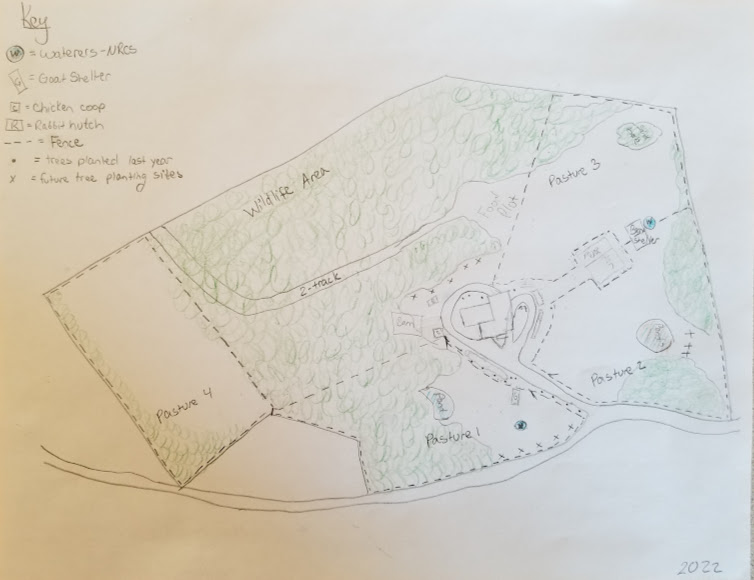Farm Map: How Planning Gives Clear Vision
How We Farm Plan
James and I are in constant communication about our dreams and visions for our farmstead. It might be an offhand comment about something we have recently viewed or read. Or, it might be more purposeful planned time set aside where we walk the property or sit down to discuss our goals. These discussions result in two things: to-do lists and a farm map.
2021: Our First Farm Map
Our first year of planning was on a smaller scale. We could only work with the area around the house and driveway. Though our scale was small, we were able to establish many components that bring the “perennial” to Perennial Acres Holmestead. On the approximate acre that we could use, we planted:
- Blueberries
- Strawberries
- Rhubarb
- Apples
- Apricots
- Figs
- Persimmons
- Maples
- Serviceberries
Most of these take years before they are fruit-bearing. That is why it was so important to us to get them planted in our first year. Planting these things also took careful consideration: Where can we put them now so they won’t be in the way later? How will they enhance the landscape?

While our space was small, because of careful planning and mapping, we had ample room for chickens, rabbits, and pigs. We also set up a composting bin. Our property is very sloped and it was imperative that we saved the flattest areas for animal shelters. The next priority was where to put our garden (which ended up being spread around the house). Lastly, we filled in with trees and bushes.
2022: A Look Into the Future
As we begin a new year and have many planned changes for the property, James and I have purposefully discussed our map, both for this year and far into the future. The results of this are the farm maps below.

These farm maps are a culmination of both formal and informal discussions over the last year. They are also set on two different scales: the area closer to the house and the property as a whole. This is the year we will be able to branch out from around our home.
For 2022, we will establish Pasture 1. While our primary livestock will be goats, we hope to have a mixed herd of many animals that can work together to maximize the output of the land. Although there are possible “barn” sites labeled on our farm plan, those are sites reserved for building years from now, utilizing smaller shelters for the time being.
In addition to expanding our livestock, we will also expand our garden. In the next few weeks, we will move our pigs to what will be the new garden plot so they can prepare it for planting. We have ordered trees from Tennessee Tree Day and are working toward finalizing their planting location. We anticipate being able to also source trees from Johnson City Arbor Day and to participate in an Extension Office tree grafting class for fruit trees. Additionally, we need to plan (and prepare) for where to plant the blueberries and grapes we were gifted from a friend who acquired them through an end of season clearance.
How to Make Your Own Farm Map
First, you need to start with a sketch of your property. I took a screenshot of our property on Google Maps, printed it out in black and white, and then traced it onto paper.
Then, you need to get to know your land. Walk around your property in all weather, times of the day, and seasons. Look for water issues, where the sun and shade are, and get to know what plants are already there and if you want to keep them or if they need to be removed. Mark these findings on your farm map. Also make note of aspects you cannot change and must work around such as septic tank, well, powerlines, underground pipes or electrical, and landforms.
Now that you know your land, think about how you can work with what is already there. What are your top priorities for the things you want to add or change? How can you realistically make it work in the space you have?
As you move through these steps, layer by layer you will develop a farm map that is unique to you and your own vision of what you hope to accomplish. What we found important was not to rush this process. That is a large part of why we continued the cattle lease on our property for a year. It takes many weeks (and for some months or years) of observations and careful consideration. I hope our farm maps along with these steps can get you started with putting your ideas on paper. Happy planning!
